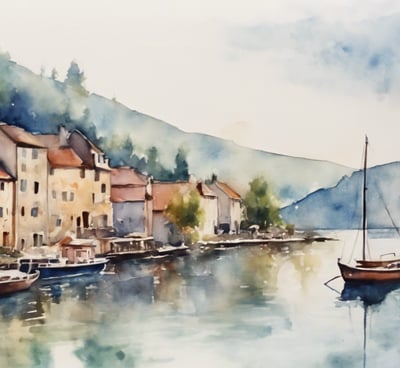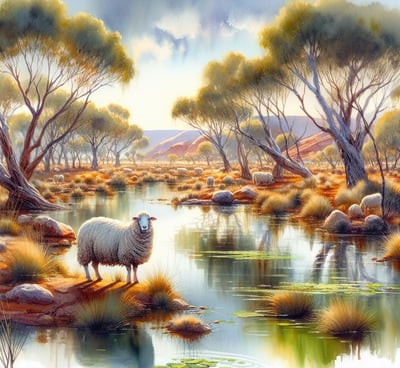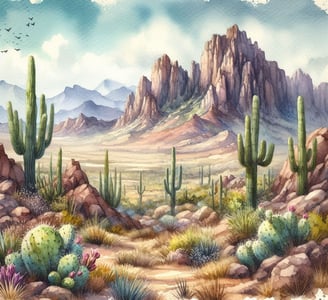Things I Wish I Knew Before I Started Doing Watercolor
If you want to be a watercolor artist, you may find yourself on a fascinating and demanding journey. What I wish I had known before starting.....
WATERCOLOR ART
12/9/20234 min read


Introduction
If you want to be a watercolor artist, you may find yourself on a fascinating and demanding journey. It takes time, effort, and passion to create great watercolor paintings. While the process can be fulfilling and rewarding, there are a few things I wish I had known before diving into the world of watercolor. In this blog post, I will share some valuable insights and tips that can help you navigate your own watercolor journey more smoothly.
1. Quality Materials Matter
One of the first lessons I learned is that investing in quality materials is essential for achieving good results. While it can be tempting to buy cheaper supplies when starting out, they often lack the pigmentation and durability necessary for creating vibrant and long-lasting watercolor paintings.
Opt for professional-grade watercolor paints, high-quality brushes, and acid-free watercolor paper. These materials may cost more, but they will make a noticeable difference in the outcome of your paintings. Remember, your tools are an investment in your artistic journey.
2. Practice Makes Progress
Watercolor is a medium that requires practice and experimentation. Don't be discouraged if your initial attempts don't turn out as you hoped. Embrace the learning process and keep practicing. Each stroke of the brush and each painting you create will contribute to your growth as an artist.
Set aside regular time for painting, even if it's just a few minutes a day. Consistency is key when it comes to improving your skills. Consider joining a local art group or taking online classes to learn from other artists and gain valuable feedback.
3. Embrace the Unpredictability
Unlike other mediums, watercolor has a mind of its own. Embrace the unpredictability and let go of the need for complete control. Watercolor paintings often have a beautiful, organic quality precisely because they are not entirely predictable.
Experiment with different techniques, such as wet-on-wet, wet-on-dry, and layering. Allow the paint to flow and blend naturally on the paper. Embrace happy accidents and learn to work with them rather than against them. Sometimes the most unexpected outcomes can lead to the most interesting and unique paintings.
4. Understand Color Theory
Understanding color theory is crucial for creating harmonious and visually pleasing watercolor paintings. Familiarize yourself with the color wheel and learn about primary, secondary, and tertiary colors. Understand how different colors interact with each other and how to create various shades and tones.
Experiment with mixing colors to create your own unique palette. Learn about warm and cool colors and how they can evoke different moods and emotions in your paintings. A solid foundation in color theory will give you more control and confidence when choosing and mixing colors.
5. Patience is a Virtue
Watercolor requires patience. Unlike acrylic or oil paints, watercolor dries quicker and takes time to settle on the paper. Rushing the process can lead to muddy colors and unwanted blending. Allow each layer to dry completely before adding another, and be patient with yourself as you navigate the learning curve.
Remember that watercolor paintings often require multiple layers to achieve depth and richness. Building up layers gradually will result in more vibrant and professional-looking paintings. Don't be afraid to take breaks and step away from your painting to gain a fresh perspective.
6. Learn to Preserve Your Work
Watercolor paintings are delicate and can be easily damaged if not properly preserved. Invest in a good quality fixative or spray varnish to protect your finished paintings from smudging, fading, and moisture. Frame your artwork behind glass to shield it from dust and UV rays.
When storing your paintings, make sure they are completely dry and flat to avoid any warping or damage. Use acid-free mats and backing boards to prevent any discoloration over time. Taking these precautions will ensure that your watercolor paintings stand the test of time.
7. Find Your Style
While it's important to learn from other artists and experiment with different techniques, don't be afraid to develop your own unique style. Explore what interests and inspires you, and let your personality shine through your paintings.
Experiment with different subjects, styles, and color palettes until you find what resonates with you. Your style will evolve and change over time, so embrace the journey of self-discovery and allow yourself the freedom to create without limitations.
Conclusion
Embarking on a watercolor journey can be both challenging and rewarding. By investing in quality materials, practicing regularly, embracing the unpredictability, understanding color theory, being patient, learning to preserve your work, and finding your own style, you can set yourself up for success as a watercolor artist.
Remember, the most important thing is to enjoy the process and have fun with your paintings. With time and dedication, you'll see yourself grow and create beautiful watercolor artworks that reflect your unique artistic voice.
Check out my Youtube channel to see some of the my watercolor creations.
“Creativity is allowing yourself to make mistakes. Art is knowing which ones to keep.” – Scott Adams
Below are typical examples of watercolor art. Please feel free to use them as your inspiration. Note! I did not paint these beautiful pieces.






